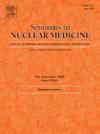Update on Molecular Imaging in Epilepsy
IF 5.9
2区 医学
Q1 RADIOLOGY, NUCLEAR MEDICINE & MEDICAL IMAGING
引用次数: 0
Abstract
Epilepsy is one of the commonest neurological disorders worldwide. It is characterized by recurrent unprovoked seizures and has significant effects on one’s daily life. Though almost two thirds of patients with epilepsy respond well with one or more antiepileptic drugs, about 30% patients suffer with drug resistant epilepsy (DRE). Patients with focal variant of DRE, often have a focal pathology in brain and benefit vastly by removing or disconnecting the foci of origin of epileptiform waves from other parts of the cerebral cortex. While clinical examination, MRI and EEG are the first line investigations done in such patients before surgery, many a times they yield normal or discordant or multiple lesions of which only 1 or 2 are epileptogenic. It is in such cases; molecular imaging such as SPECT and PET helps in accurately demarcating the EZ for planning epilepsy surgery. The functional integrity of the rest of the brain can also be assessed by PET and SPECT, which may also offer valuable insights into the potential pathophysiology of the neurocognitive and behavioral impairments commonly seen in these patients. Epilepsy continues to be a common indication for perfusion SPECT as it is the only imaging method that can visualize the ictal onset zone in vivo. Interictal FDG PET/CT is a single investigation that can provide most information about EZ whereas SPECT has to be done twice—ictal and interictal. The evolution of advanced image analysis techniques like SISCOM, SISCOS, PISCOM and newer receptor-based PET tracers has further refined the localization of the seizure onset zone.
癫痫分子影像学研究进展。
癫痫是世界上最常见的神经系统疾病之一。它的特点是反复发作的无端发作,对一个人的日常生活有重大影响。虽然近三分之二的癫痫患者对一种或多种抗癫痫药物反应良好,但约30%的患者患有耐药癫痫(DRE)。局灶性DRE变异型患者通常在大脑中有局灶性病理,通过从大脑皮层的其他部分切除或断开癫痫样波的起源灶,可以极大地获益。虽然临床检查,MRI和EEG是术前对这类患者进行的一线检查,但很多时候它们显示正常或不一致或多个病变,其中只有1或2个是癫痫性的。在这种情况下;分子成像如SPECT和PET有助于准确地划定EZ,以便计划癫痫手术。脑其他部分的功能完整性也可以通过PET和SPECT进行评估,这也可能为这些患者常见的神经认知和行为障碍的潜在病理生理学提供有价值的见解。癫痫仍然是灌注SPECT的一个常见适应症,因为它是唯一一种能够在体内可视化癫痫发作区的成像方法。间歇期FDG PET/CT是一次检查,可以提供关于EZ的大部分信息,而SPECT必须进行两次间歇期和间歇期。先进的图像分析技术,如SISCOM, SISCOS, PISCOM和新的基于受体的PET示踪剂的发展,进一步完善了癫痫发作区域的定位。
本文章由计算机程序翻译,如有差异,请以英文原文为准。
求助全文
约1分钟内获得全文
求助全文
来源期刊

Seminars in nuclear medicine
医学-核医学
CiteScore
9.80
自引率
6.10%
发文量
86
审稿时长
14 days
期刊介绍:
Seminars in Nuclear Medicine is the leading review journal in nuclear medicine. Each issue brings you expert reviews and commentary on a single topic as selected by the Editors. The journal contains extensive coverage of the field of nuclear medicine, including PET, SPECT, and other molecular imaging studies, and related imaging studies. Full-color illustrations are used throughout to highlight important findings. Seminars is included in PubMed/Medline, Thomson/ISI, and other major scientific indexes.
 求助内容:
求助内容: 应助结果提醒方式:
应助结果提醒方式:


